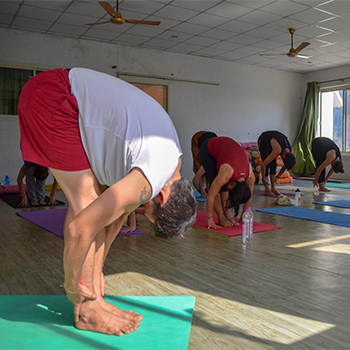The Spiritual Sojourn: The History and Significance of Yoga in Rishikesh
Share this Post to earn Money ( Upto ₹100 per 1000 Views )

Rishikesh, a city of spiritual awakening and yogic enlightenment, is nestled in the lap of the Himalayas beside the holy Ganges. Rishikesh, also referred to as the "Yoga Capital of the World," has a rich history of myths and tales surrounding it, making it a hub for spiritual exploration. This blog explores the evolution of this sacred practice, the history of yoga in Rishikesh, and the reasons why Rishikesh is regarded as the global hub for yoga enthusiasts.
The Historical Roots of Yoga in Rishikesh
From ancient times, yoga, which has its roots in India over 5,000 years ago, has been an integral element of Rishikesh's spiritual landscape. The ancient sages and seers who meditated and followed austere lifestyles along the banks of the Ganges are entwined with the city's yogic history. Rishikesh has long been thought to be a suitable location for spiritual activities because of its calm and peaceful surroundings.
The Sage Connection
The famous sage Raibhya Rishi is the source of Rishikesh's lore and the link between it and yoga. Legend has it that following his strict penance, Lord Vishnu materialized before him as Hrishikesh, hence the city's name. This celestial experience brings to light the city's long history of yoga and spiritual practices.
The Advent of Organized Yoga Practices
The official inception of yoga in Rishikesh may be traced back to the foundation of multiple ashrams during the early 1900s. These ashrams served as hubs for intense yogic study and practice in addition to being retreats. They were essential in systematizing yoga techniques and opening them up to seekers and regular people worldwide, in addition to ascetics.
Rishikesh: The Global Yoga Capital
The 1960s were a pivotal period in Rishikesh's development as the world's center of yoga. When The Beatles visited the ashram of Maharishi Mahesh Yogi in 1968, Rishikesh became a well-known spiritual and yoga destination worldwide. Since then, this holy city has drawn hundreds of celebrities, yoga instructors, and spiritual seekers seeking enlightenment and inner serenity.
The International Yoga Festival
The International Yoga Festival, held in Rishikesh each year, draws practitioners of yoga from more than 100 nations. The Parmarth Niketan Ashram, in association with the Uttarakhand Tourism Development Board, is organizing a week-long festival that features a range of yoga methods, meditation sessions, and spiritual talks delivered by distinguished practitioners. As the embodiment of yoga's universal appeal and unifying force, Rishikesh is without a doubt its home.
The Ashrams: Centers of Yogic Wisdom
The foundation of Rishikesh's yogic heritage are the ashrams. With a foundation in ancient yogic traditions, they provide a wide range of yoga programs, from introductory classes to advanced teacher training.
Kailasa Yoga
Kailasa Yoga is your premier institution for those looking to deepen their knowledge and practice yoga. This Ashram prides itself on providing comprehensive programs that incorporate the physical, mental, and spiritual aspects of yoga. At Kailasa Yog, students will deepen their understanding of the yogic tradition, while also gaining practical skills and experiences necessary to teach yoga and share the knowledge with others.
Parmarth Niketan
One of the biggest ashrams in Rishikesh, Parmarth Niketan, is well-known for its yoga and meditation programmes, spiritual retreats, and the magnificent Ganga Aarti in the evening. It promotes a life of self-control, chastity, and service and embraces the spirit of yogic living.
Sivananda Ashram
This ashram, which Swami Sivananda founded, is well-known for its extensive yoga teacher training programs. By highlighting the integration of the four yoga paths—Karma, Bhakti, Jnana, and Raja Yoga—it encourages a well-rounded and comprehensive approach to spiritual practice.
The Beatles Ashram
Now a part of the Rajaji National Park, the Chaurasi Kutia or The Beatles Ashram, is a testament to Rishikesh’s global yoga legacy. Although it no longer operates as a functioning ashram, it attracts tourists for its historic significance and the stunning murals that adorn its walls, celebrating the Beatles’ visit and the universal message of peace and love.
The Significance of Yoga in Rishikesh
Yoga in Rishikesh is not merely about physical postures or asanas; it is a comprehensive spiritual journey. The city, with its sacred vibes and natural beauty, amplifies the essence of yoga, which is union - the union of the body with the mind, the human with the divine.
A Spiritual Sanctuary
Rishikesh offers a sanctuary from the chaos of modern life, a place where one can embark on the inward journey of self-discovery and spiritual growth. The teachings here go beyond the physical aspects of yoga, delving into meditation, breath control (pranayama), and the ethical principles of yoga (yamas and niyamas), fostering a transformation that is deeply spiritual.
Learning and Living Yoga
The immersive experience in Rishikesh allows for a living practice of yoga. It’s not just about attending classes but living the yogic lifestyle - waking up to the serene Ganges, meditating by its ghats, practicing asanas with a view of the Himalayas, and participating in satsangs and kirtans. This holistic experience facilitates a profound connection with the self and the universe.
Conclusion
The history and significance of yoga in Rishikesh are as vast and deep as the Ganges that flows through this sacred city. Rishikesh is not just a destination; it’s a journey into the heart of yoga, offering lessons that resonate with the soul. Whether you are a seasoned practitioner or a curious seeker, Rishikesh welcomes all who are on a quest for spiritual enlightenment and self-discovery. In the age-old streets of Rishikesh, yoga is not just practiced; it is lived, breathed, and experienced in its most authentic and transformational form.







